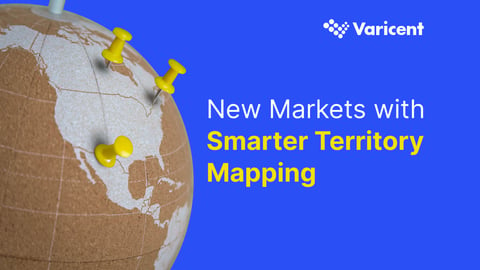Sales territory mapping is a core component of the territory planning process that informs the yearly (or regularly scheduled) sales plan. Basically, you are laying the groundwork for assigning territories by defining the area, sales, and revenue that your sellers are responsible for targeting. The aim is to reach the right customers, meet revenue goals, and promote growth.
Sales Territory Mapping Factors and Considerations
Sales leaders know that territory mapping has never been easy, even during the times when each territory was basically a geographic area. They had to factor in geographic data, zip codes, state boundaries, number of existing customers, number of prospects that meet a target demographic, and internal and external factors that affect the territories and sales potential. Often, despite their best efforts, there were coverage gaps that affected sales reps and opportunities.
Now, as we all well know, territories are even more complicated. In this blog, we look at what is involved in a modern sales territory plan—and what kind of software is built to handle it.
Whether you’re mapping territories or setting targets, sales planning technology can make it easier. Read the Forrester report that explains how.
Why is a Sales Territory Plan So Beneficial to Growth?
Mapping sales territories correctly enables you to better plan for revenue growth. A well-designed sales territory plan helps increase:
- Sales volume and market coverage while providing better services to customers.
- Profits by adjusting the size of a dedicated sales force to an optimal size and reach.
- Revenue by redistributing effort toward client accounts with the highest engagement and greatest incremental revenue per call.
Other benefits include better client coverage, which drives improved client satisfaction. You eliminate outreach redundancy, which decreases client fatigue. And, finally, effective and accurate sales territory mapping enables you to implement an outbound sales strategy that appropriately matches the size of the territory, thereby decreasing travel expenses.
By contrast, if sales territories are poorly planned, team members are likely to feel all over the place, and that can have an adverse effect on achieving the best results for your customers or your organization. So, what can you do to make sure you avoid these issues and take advantage of the benefits of modern sales territory mapping? A recognition that you must consider some new factors and make some tweaks to how you map territories now.
Sales Territory Plan Requirements Today
Remote work and virtual meetings have thrown sales reps routes and calling on prospects out the window, along with territories that focus only on geography. Territories are now just as likely to be based on industries, top accounts, and products as they are on geography—and it’s even more likely that they’re a combination of two or more of these things. Assigning territories has also changed. A majority of the participants in a Cascade and Varicent study of 607 companies indicated that they assign sellers to territories based on their skill sets rather than where they are located.
And as companies grow, sales leaders are merging plans and designing unique ways to galvanize their teams. As a result, sales territory mapping is more complex than it’s ever been. The factors used to map a territory like zip code, state boundaries, number of customers, and so on are still there, for starters. However, because of all the different ways territories are defined now, you also need to factor in whether to keep any existing territories, the impact of competitors in a territory, previous customers, and product history. Then sales leaders must consider whether sales professionals in a team have the right skills and experience for that territory.
If you are using spreadsheets, spreadsheet mapping add-ons, territory mapping capabilities, or plug-ins that must be integrated with enterprise planning tools or customer relationship management (CRM) applications, all these considerations can get tricky. Mapping territory hierarchies can be difficult and coverage gaps are not easy to see.
To meet sales territory mapping, design, and planning requirements today, you need a tool that not only addresses those factors but quota allocation and planning, as well.
Create Sales Territory Mapping Plans and Quota Allocations Designed for Growth
Sales territory mapping software can be useful in many cases, but if you want to plan for growth, you need to do more than territory planning. Therefore, you need a purpose-built tool that merges quota allocations with territory design, mapping, and planning to deliver data-driven sales plans. Imagine carving out territories and quotas collaboratively, not in silos, and reconciling top-down and bottom-up planning because you can do both in the same tool. And there goes a major source of friction in your sales planning process.
You can see how plan adjustments might play out and adapt your strategy accordingly before you deliver your plans—on time. You can allocate quotas with support from the people to whom they matter most—your sales team and management. This is likely to invigorate your sellers. With the time and freedom to analyze your data, you can uncover new territories or even ditch unsuccessful ones in favor of something new. Gaps and outliers in your planning are easy to spot, along with untapped opportunities.
Maximize Sales Potential with Smarter Territory and Quota Planning
Smarter territory and quota planning from Varicent ensures effective sales territory mapping. Varicent Territory and Quota Planning integrates all your data seamlessly into one purpose-built application, enabling you to plan by geography, by industry, by named accounts, by product, or any combination. You can adapt quickly to new organizational demands and remove bias by using internal metrics. Guided intelligence accelerates the process and eliminates surprises by making the unseen visible with battle cards, maps, and territory organizational structure. Collaboration capabilities achieve buy-in and automated workflows designed to improve engagement, transparency, and tracking.
To learn more, schedule a demo with a Varicent expert, today!




